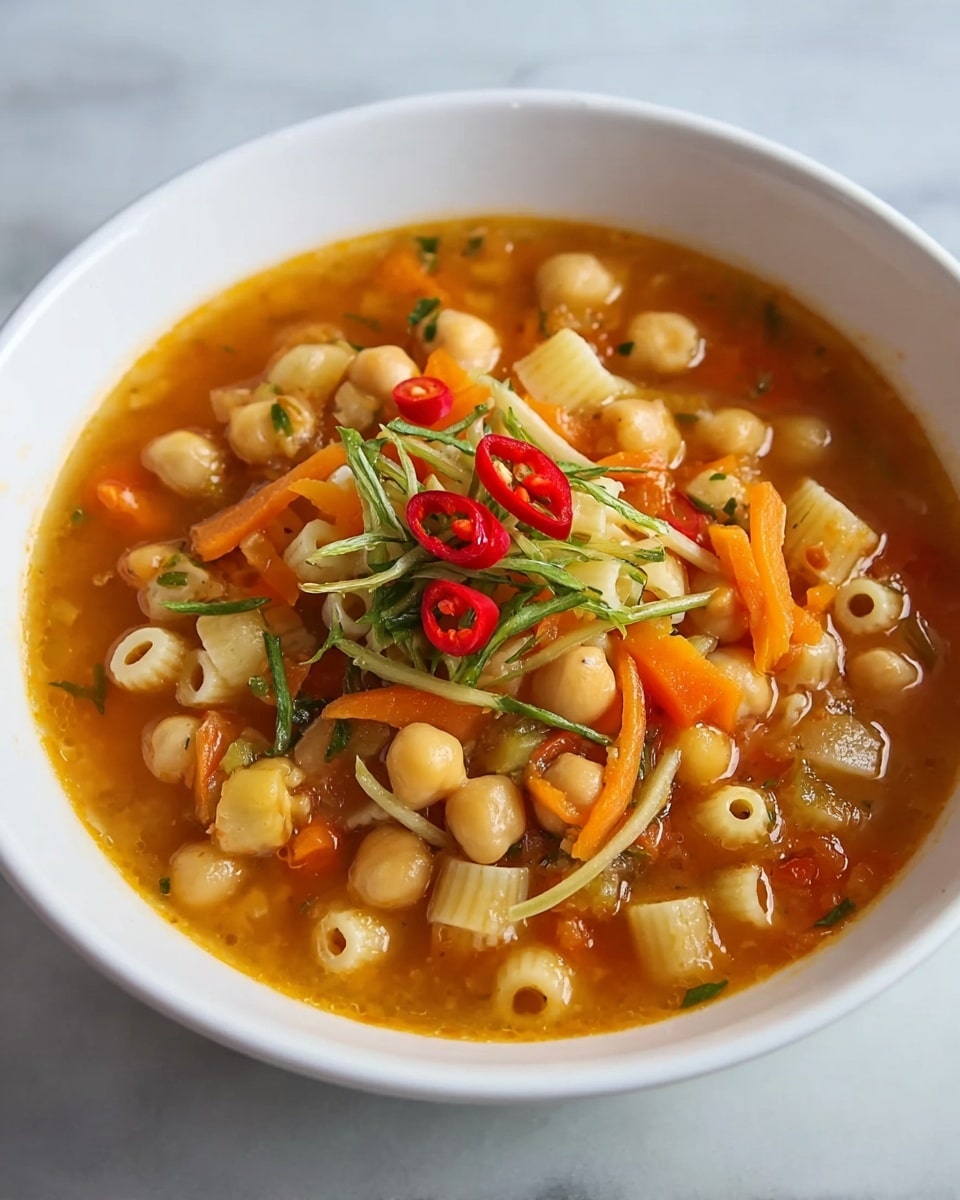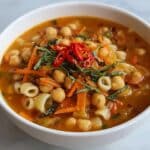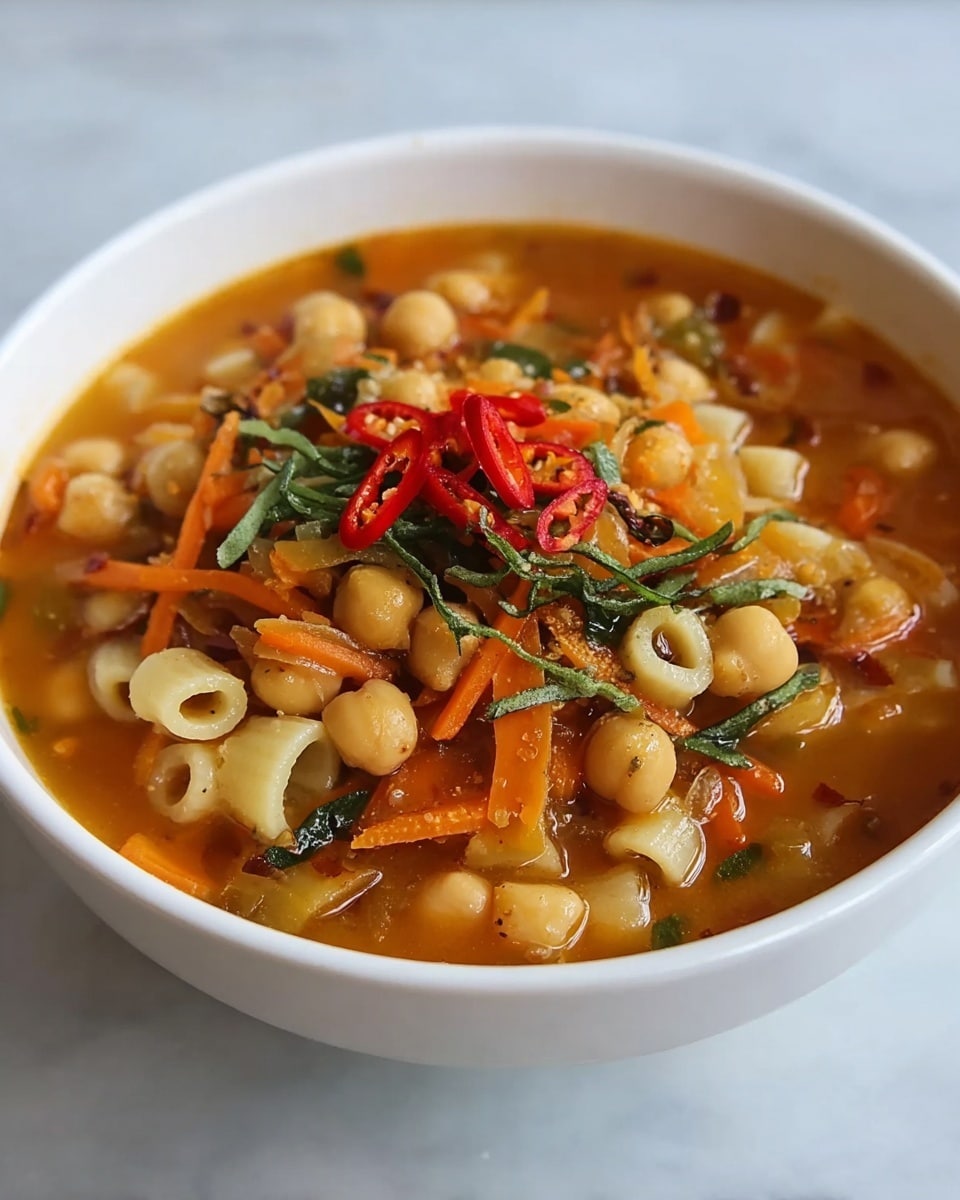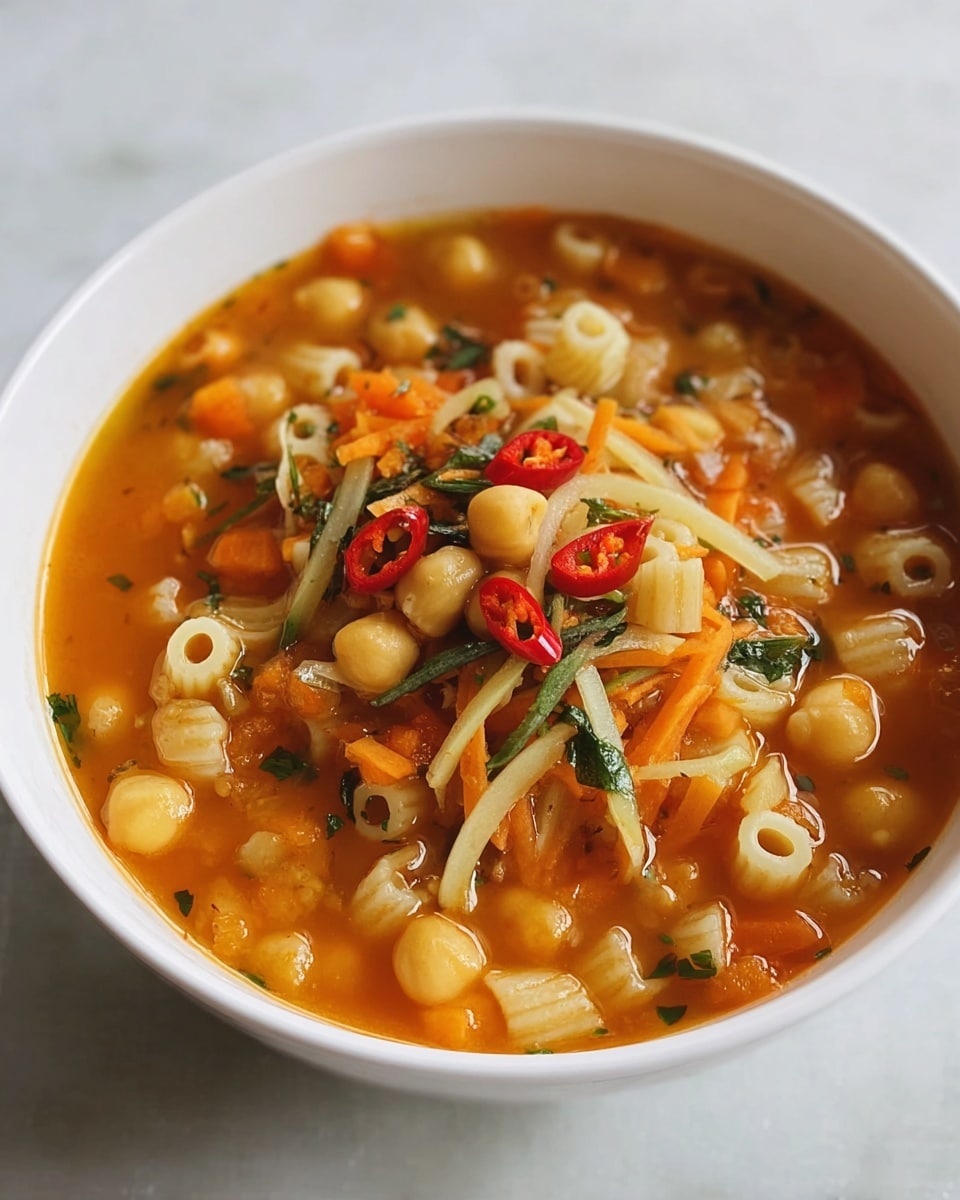If you’re craving a comforting, hearty stew that feels like a warm hug from the Italian countryside, you’re in the right place. I absolutely adore this Pasta e Ceci (Italian Chickpea and Pasta Stew) Recipe because it’s easy to make, packed with wholesome flavors, and brings my family running to the table every time. I can’t wait to share all the tips and tricks that help this humble dish shine in your kitchen just like it does in mine.
Why You’ll Love This Recipe
- Hearty and Nourishing: Chickpeas and pasta come together to create a stew that’s both filling and comforting on chilly days.
- Fresh Herb Flavor: Using fresh sage, rosemary, and thyme gives this dish an authentic Italian aroma you’ll adore.
- Texture Magic: Grating the vegetables instead of dicing creates a melt-in-your-mouth texture that’s surprisingly delightful.
- Customizable Spice Level: You control how much heat to add with fresh cayenne pepper, perfect for picky eaters or spice lovers alike.
Ingredients You’ll Need
The magic of this Pasta e Ceci (Italian Chickpea and Pasta Stew) Recipe really starts with simple ingredients that combine beautifully. Look for quality canned tomatoes and fresh herbs if you can — they make a world of difference!
- Dry chickpeas: Soaking them overnight makes them tender and digestible — trust me, it’s worth the wait.
- Baking soda: A small addition that helps soften chickpeas while soaking. It sounds odd but works like a charm.
- Yellow onion: Grated for subtle sweetness that blends right into the stew.
- Celery stalk: Adds a nice mellow flavor and done grated, it thickens the stew perfectly.
- Small zucchini: The zucchini melts down when grated, adding moisture and a gentle earthiness.
- Carrot: Grated like the others to keep that beautiful stew-like texture.
- Olive oil: Use a good quality extra virgin olive oil for sautéing and drizzling at the end — it elevates the whole dish.
- Fresh sage, rosemary, and thyme: Fresh herbs are a game changer here; dry herbs just don’t have the same vibrant aroma.
- Chicken broth: This is your stew’s soul — adjust the amount to get your preferred thickness.
- Stewed peeled tomatoes: Canned is fine, but look for “stewed” or crushed to get that perfect rustic texture.
- Pasta ditalini: Little pasta shapes like ditalini are ideal for this stew since they hold the liquid well — but broken spaghetti works in a pinch.
- Salt and pepper: Essential finishing seasoning — always taste before final seasoning.
- Fresh cayenne pepper: Seeded and minced for a fresh spicy kick, easily adjusted to your liking.
- Extra-virgin olive oil: Just a drizzle on top before serving for richness and shine.
Variations
I love how this pasta and chickpea stew adapts so well to what you have on hand or your dietary needs. Take this as a canvas — add or subtract to make it truly yours.
- Vegetarian version: Use vegetable broth instead of chicken broth; the flavors still shine bright and it’s just as comforting.
- Vegan twist: Swap out the mantequilla (butter) for more olive oil, and skip adding cheese if you’d normally top it with parmesan.
- Hearty greens: Stir in chopped kale or spinach near the end of cooking for extra color and nutrition — my family loves the pop of green.
- Spicy adjustments: If you like things hotter, increase the cayenne pepper or add a pinch of red pepper flakes during sautéing.
How to Make Pasta e Ceci (Italian Chickpea and Pasta Stew) Recipe
Step 1: Soak Your Chickpeas Right
This first step really sets you up for success. I always rinse the chickpeas under cold water, rubbing them gently to clean away any dust or skins. Then, soak them overnight in plenty of water with a tablespoon of baking soda — this softens them beautifully. I’ve found that the baking soda trick cuts soaking time a bit and gives a smoother texture, so don’t skip it!
Step 2: Grate Your Vegetables for Perfect Texture
Instead of dicing, I grate the onion, celery, zucchini, and carrot on the large teeth of a box grater. This step is a little game-changer because it releases the veggies’ natural sweetness and thickens the stew as they melt into it. The texture feels much more rustic and comforting than chunks of vegetables—trust me, your taste buds will thank you.
Step 3: Sauté and Infuse the Herbs
Heat the olive oil in your stew pot, then toss in the grated veggies along with sprigs of sage, rosemary, and thyme. Sauté everything together for about five minutes until the onion softens and the aroma fills your kitchen. This part smells amazing and really breathes life into the stew’s base flavor.
Step 4: Simmer Chickpeas and Tomatoes
After your veggies and herbs are ready, add in the soaked and rinsed chickpeas, stewed peeled tomatoes, and about three cups of chicken broth. Bring it up to a boil, then lower to a gentle simmer. This step takes patience — about an hour until the chickpeas are tender but not mushy. I usually check toward the end and add broth bit by bit to keep this stew thick without drying out.
Step 5: Cook the Pasta Perfectly
Once your chickpeas are tender, stir in the ditalini pasta. Cooking time varies, but usually around 8 to 10 minutes gives you “al dente” bite — not mushy, not hard. Keep a close eye here and taste-test to get it just right. Add more broth if you want a soupier texture, or less if you prefer stew consistency.
Step 6: Final Seasoning and Serving
Season your Pasta e Ceci with salt and pepper to taste. I like to serve it with a sprinkle of minced fresh cayenne pepper on top to add a fresh pop of heat, and a generous drizzle of extra-virgin olive oil before bringing it to the table. That olive oil finish always feels so indulgent and carries the flavors perfectly.
Pro Tips for Making Pasta e Ceci (Italian Chickpea and Pasta Stew) Recipe
- Don’t Rush the Soak: Soaking chickpeas overnight with baking soda softens them perfectly, avoiding tough bites later.
- Grate Instead of Chop: I learned this trick from a Tuscan cook — it changes the stew’s texture and flavor completely.
- Herbs on a String: Tie your fresh herbs together for easy removal after simmering, so you get flavor without stray leaves in the stew.
- Add Pasta Last: Prevent mushy pasta by stirring it in near the end and cooking just until tender.
How to Serve Pasta e Ceci (Italian Chickpea and Pasta Stew) Recipe

Garnishes
I always go for a fresh minced cayenne pepper if I want a bit of heat, and never skip a drizzle of fruity extra-virgin olive oil on top. Sometimes I add a sprinkle of grated aged pecorino or parmesan for richness, but it tastes just as amazing without cheese for a lighter touch.
Side Dishes
This stew pairs wonderfully with crusty Italian bread to soak up every last bit. I also love serving it alongside a simple green salad with lemon vinaigrette to brighten the meal. When I’m feeling indulgent, a plate of sautéed greens or roasted veggies rounds things out beautifully.
Creative Ways to Present
For special occasions, I’ve served this stew in chilled oversized pasta bowls topped with fresh herb sprigs and a swirl of extra-virgin olive oil. Setting the table with rustic linen napkins and a carafe of Italian red wine makes it feel like you’re dining in a Tuscan trattoria — a real crowd-pleaser!
Make Ahead and Storage
Storing Leftovers
I love this stew for leftovers because the flavors deepen overnight. Store it in an airtight container in the fridge for up to 3 days, and you’ll notice it tastes even better the next day. Just give it a good stir before reheating.
Freezing
Freezing this Pasta e Ceci works well, but I recommend slightly undercooking the pasta during the initial cooking so it doesn’t get mushy when thawed. Freeze in portioned containers for easy defrosting, and it makes a lifesaver weeknight dinner.
Reheating
Reheat gently on the stovetop over medium-low heat, stirring often and adding a splash of broth or water to loosen up the stew if it’s thickened. I avoid the microwave if I want to keep the texture just perfect, but it works fine if you’re in a hurry.
FAQs
-
Can I use canned chickpeas instead of dry for this Pasta e Ceci recipe?
Absolutely! Using canned chickpeas can save you time; just rinse and drain them well. Keep in mind, since canned chickpeas are already cooked, you’ll want to add them later in the cooking process to avoid them turning mushy. Adjust cooking times accordingly and watch the stew’s thickness since you might need less broth.
-
What pasta can I use if I don’t have ditalini?
If you can’t find ditalini, small shapes like elbow macaroni, or broken spaghetti pieces work wonderfully. The idea is to use a small pasta that mixes well with the chickpeas and holds some broth. I’ve made this with broken thin spaghetti and it turned out great every time.
-
Can I make this dish vegan?
Definitely. Swap chicken broth for a rich vegetable broth and use extra olive oil instead of butter (though this recipe uses only olive oil). Skip any cheese garnishes if you’d normally use them. The stew remains hearty and deeply satisfying without any animal products.
-
How spicy should I make the stew with cayenne pepper?
That’s totally up to your palate! I like starting with a small amount of minced fresh cayenne on each serving so you can control the heat. The fresh pepper adds brightness beyond just spice. If you prefer a milder dish, skip the cayenne or use less. You can always add it on the side for spice lovers at the table.
Final Thoughts
This Pasta e Ceci (Italian Chickpea and Pasta Stew) Recipe has been such a cozy cornerstone for my family dinners, especially during colder months when we crave something simple yet soulful. It feels humble yet special, and once you’ve tried grating those veggies and simmering those herbs, you’ll understand why it’s a favorite. I hope you enjoy this recipe as much as I do — cook it for your loved ones, share a few stories over the pot, and savor every comforting bite. Trust me, you’ll be making it again and again.
Print
Pasta e Ceci (Italian Chickpea and Pasta Stew) Recipe
- Prep Time: 30 minutes
- Cook Time: 75 minutes
- Total Time: 8 hours 45 minutes
- Yield: 6 servings 1x
- Category: Soup/Stew
- Method: Stovetop
- Cuisine: Italian
- Diet: Gluten Free
Description
Pasta e Ceci is a traditional Italian chickpea and pasta stew that offers a comforting and hearty meal. With grated vegetables sautéed to enhance flavor, tender chickpeas, and small pasta shapes simmered in a savory broth with fresh herbs, this dish combines rustic textures and rich, satisfying tastes. Ideal for a cozy dinner, it’s finished with a spicy kick of cayenne pepper and a drizzle of olive oil for depth.
Ingredients
Chickpeas and Soaking
- 1 cup dry chickpeas
- 1 tablespoon baking soda
Vegetables
- 1 yellow onion
- 1 stalk celery
- 1 small zucchini
- 1 carrot
Herbs and Flavorings
- 1 sprig fresh sage leaves
- 1 sprig fresh rosemary
- 1 sprig fresh thyme
- 1 fresh cayenne pepper, seeded and minced (or more to taste)
- Salt and pepper to taste
Liquids and Oils
- 2 tablespoons olive oil
- 3 to 5 cups chicken broth, as needed
- 2 stewed, peeled tomatoes
- 1 tablespoon extra-virgin olive oil (for finishing)
Pasta
- 240g pasta ditalini, such as Barilla® Gluten Free Ditalini
Instructions
- Soak the Chickpeas: Rinse the dry chickpeas thoroughly under cool water, rubbing them in your hands to clean. Place them in a large stew pot and cover with water; add the baking soda and swirl to distribute it. Allow the chickpeas to soak for 8 hours or overnight to soften.
- Rinse Post-Soak: The next day, drain the chickpeas through a strainer and rinse well under cold running water to remove any skins or discolored legumes. Set aside.
- Prepare Vegetables: Using the large teeth of a cheese grater, grate the onion, celery, zucchini, and carrot. This technique imparts a delicate texture and flavor that differ from dicing.
- Sauté Vegetables and Herbs: Heat 2 tablespoons of olive oil in the stew pot over medium heat. Add the grated vegetables and sauté for 1 minute. Incorporate the fresh sage, rosemary, and thyme, and continue to sauté, stirring occasionally, until the onions become soft and translucent, approximately 5 minutes.
- Add Broth and Chickpeas: Pour in 3 cups of chicken broth, the soaked chickpeas, and the stewed peeled tomatoes. Bring the mixture to a boil, then reduce the heat and let it simmer until the chickpeas are tender, about 1 hour.
- Add Pasta and Adjust Consistency: Stir in the ditalini pasta and add more broth as needed to maintain a thick, stew-like consistency. Cook until the pasta is tender but still has a slight bite, 8 to 10 minutes.
- Season and Serve: Taste the stew and season with salt and black pepper accordingly. Remove from heat, divide the stew into serving bowls, and top each with the minced cayenne pepper and a drizzle of extra-virgin olive oil for a spicy and flavorful finish.
Notes
- Pasta e Ceci is a classic Italian comfort food known for its hearty and rustic qualities.
- If ditalini pasta is unavailable, you can substitute with broken spaghetti pieces or other small pasta shapes.
- The grated vegetables create a unique texture and flavor compared to chopping, making this step crucial.
- Adjust the amount of cayenne pepper to your spice preference.
Nutrition
- Serving Size: 1 cup
- Calories: 378 kcal
- Sugar: 10 g
- Sodium: 1172 mg
- Fat: 10 g
- Saturated Fat: 1 g
- Unsaturated Fat: 9 g
- Trans Fat: 0 g
- Carbohydrates: 59 g
- Fiber: 8 g
- Protein: 14 g
- Cholesterol: 2 mg



